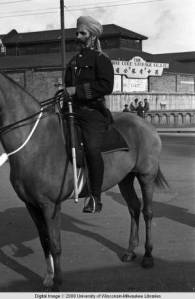Indians arrived in China with Opium wars and noticeably so during the 1898-1901 Boxer Rebellion period. Pictures and old prints from these wars showcase the Rajput, Sikh , Gurkha and Baluchi soldier from the British Indian infantry and naval forces. As British Indian subjects they fought wars for the British and were responsible for doing most of the grunge work.
Missionaries and foreigners in the Peking Legation quarter besieged by the Boxers waited for relief to arrive and when it did, the first sight they saw were the Rajputs and Sikhs riding on horses, in their magnificent turbans. Indian guards would be later employed by Chinese Christians as well fearful of attack upon them. In Singapore, in Burkit Brown ,the cemetery of a Chinese businessman has statues of Sikh guards, a telling sign of the reassurance and protection that became synonymous with Sikh soldiers.
In 1880’s however, Shanghai’s International Settlement administered by Shanghai Municipal Council would hire Sikh policemen to allay the fears of Bubbling well road residents in the wake of Sino-French war. As part of Sikh contingent in the Shanghai Municipal Police, their history has remained obscure. Much of the documentation and photographs of the policemen comes from the western perspective, hence is quite angled.
The Sikh policemen community in quasi-colony Shanghai’s international settlement was distinct on account of their appearance and harsh treatment of the Chinese especially the ricksha coolies who came for monthly inspections. The British rulers’ manipulative placement of the Sikhs between themselves and the Chinese cleverly transferred much of the Chinese aggression and ire towards the Sikhs. Even in present times, the Sikhs derogatorily referred as Hong-Tou-A-san (which loosely can be translated as the 3rd being) are remembered as the odious representatives of the British rule. With Opium wars treaty ports like Shanghai were opened up for trade and commerce and foreign companies and merchants flocked to conduct their businesses. Sikh policemen were soon employed in Tientsin (Tianjin), Hankow(Hankou) and other treaty ports. Their presence was met with interest but the dynamics of Chinese- Sikh relationship would alter .Despite the fact that Sikhs were proportionally paid less than their western counterparts, they still were better paid than the Chinese policemen. This further underlined their lowly status and naturally became one of the factors for Chinese resentment of the Sikhs.
The Pacific world war saw division of loyalties. Growing support for Subhas Chandra Bose and Indian National Army found Indian converts in Shanghai too who believed Bose to be the answer to British tyranny. Bose visited Shanghai around this time and a small unit of Indian Independence League was raised to support his cause. At the time of Japanese occupation (1937) there were many collaborators and renegades as Professor Wasserstein has mentioned in his book ‘Secret War in Shanghai’ and clearly many Indians believed Bose would attain the elusive Indian freedom.
After the Japanese were defeated and the winds of Communism were strengthening Sikh policemen and families heeded the Indian government’s call for evacuation and boarded chartered steamers for foreigners to Hong Kong, India and other countries.
This is a simple synopsis of the Indian and Sikhs’ sojourn to China and Shanghai specifically. In reality there were so many twists and turns that it would be a shame to keep their history obscure and not be genuinely understood.
